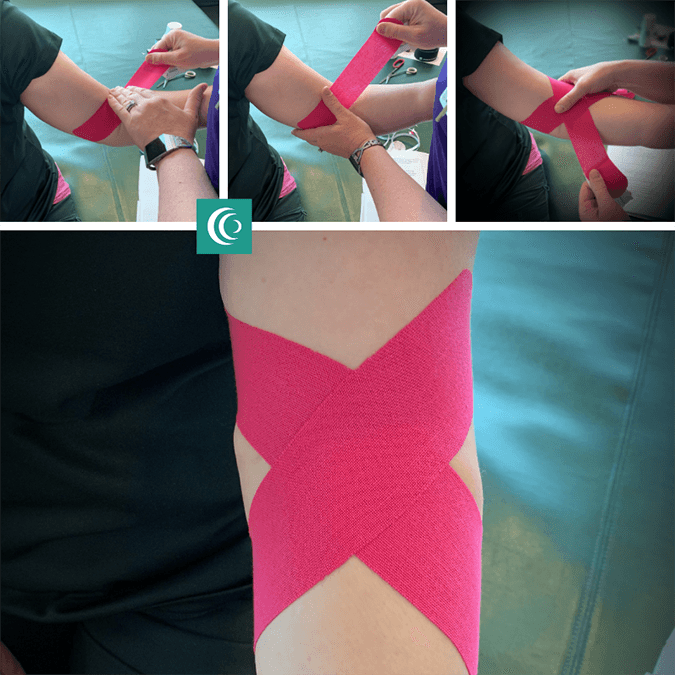You can’t go to a sporting event, the gym or even hike without seeing
someone covered in colorful tape on their shoulders, knees, ankles, elbows
and more. Fit folks these days look like they are wrapped up in huge,
colorful, Band-Aids—up one side of their body and across the other.
The brightly colored tape seems to be a craze, but not of the fashionable
kind. Perhaps more like the old man basketball survivor kind.
But, it’s not really a craze. Nor is it new. In fact, it all started with
Dr. Kenzo Kase in the 1970s, with his practice of integrative medicine. He found that
he was able to alleviate pain for his patients as he changed their movement
patterns, but their pain would return once they went home. He began experimenting
with tape, now referred to as “Kinesiology Tape,” to help
correct alignment issues, sports injuries and more.
Kinesiology Tape has several major functions:
- supporting muscle
- improving the flow of bodily fluids from the lymphatic system
- reducing inflammation
- and correcting joint problems and misalignment.
Kinesiology Tape improves range of motion and relieves pain. Common ailments
the tape can be used on include:
- muscle imbalances
- sprains to ligaments and tendons
- tendinitis
- fasciitis
- injuries to toes and fingers
- shin splints
- carpal tunnel
- postural issues
- headaches, and more.
 There are three basic kinds of tape: rigid, semi-rigid (McConnell) and
elastic tape (KT Tape, with various brand names). Each type of tape has
a different application. The tape most commonly used by general consumers is
KT Tape.
There are three basic kinds of tape: rigid, semi-rigid (McConnell) and
elastic tape (KT Tape, with various brand names). Each type of tape has
a different application. The tape most commonly used by general consumers is
KT Tape.
The use of KT Tape has become highly popular. You can use KT Tape to help
alleviate some of the common struggles the weekend warrior might experience.
The following are some tips for the general, basic use of KT Tape.
First, it’s always best to consult the experts. Your
physical therapist (PT), PT Assistant, chiropractor, sports trainer or more are qualified
to teach you how to self-treat your aches and pains from time to time.
KT Tape is safe to use for approximately two weeks, but if the issue lingers,
please see a professional.
When using KT Tape, be mindful that the material and adhesive can cause
an allergic reaction. You should always prep the skin for use—clean
the surface to be taped and follow packaging prep instructions so the
KT Tape will adhere better. Do not rip off the KT Tape when you are done
using it! KT tape should not be used without supervision in the elderly,
those who are pregnant or those with diabetes, open wounds and skin infections
or heart conditions.
Common techniques used are placing tape in a Y, I, C, fan, web and doughnut
shape. Y and I are the most common strategies. When placing KT Tape, a
general rule of thumb is to remember the tape pulls toward the origin
of insertion. Think about where the muscle group starts from and ends
at a joint and you should elongate or shorten the muscles or joint depending
on the ailment you’re treating before applying. The use of KT Tape
has become so popular to treat minor ailments, you can purchase it at
most stores—I saw an off brand in the dollar store recently—and
often you can purchase pre-cut strips that are made specifically for various ailments.
The photos below show examples of how you might tape a few used and abused
joints to alleviate pain, provide stability, and manage a sprain or strain.
Fan Shaped: alleviates inflammation

X shape: to inhibit full extension, give support and alleviate pain

Rotator Cuff: helps with postural support and to facilitate ideal movement patters

Even the weekend warrior needs help from time to time! See your physical
therapist, PTA, sports trainer or other qualified professional for more
guidance and self-care.
Have Questions?
Channa Christensen is a Physical Therapist Assistant at Campbell County Health
Rehabilitation Services. CCH’s Rehabilitation Services is the most comprehensive therapy
clinic in the Northeast, Wyoming region. Contact them today 307.688.8000
or learn more at
www.cchwyo.org/rehab.
Rachel Conrad, PBT, CPT, MA, works at CCH
Wellness as a Technician, Phlebotomist and Health Coach in Gillette, Wyoming. Campbell
County Health's Wellness works to reduce health risks and promote
overall wellness among employee groups and individuals in Campbell County,
Wyoming and beyond. To learn more about Wellness, please visit
www.cchwyo.org/Wellness or call 307.688.8051.